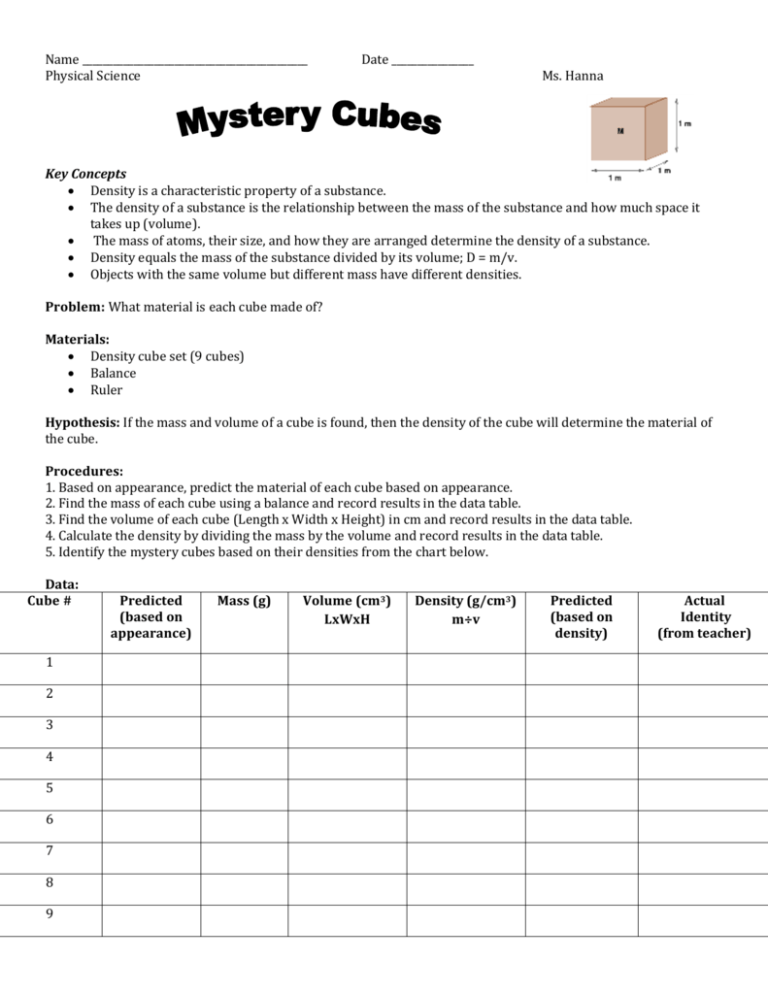Density Cube Lab - Ms. Hanna`s Science Class
advertisement

Name ____________________________________________ Physical Science Date ________________ Ms. Hanna Key Concepts Density is a characteristic property of a substance. The density of a substance is the relationship between the mass of the substance and how much space it takes up (volume). The mass of atoms, their size, and how they are arranged determine the density of a substance. Density equals the mass of the substance divided by its volume; D = m/v. Objects with the same volume but different mass have different densities. Problem: What material is each cube made of? Materials: Density cube set (9 cubes) Balance Ruler Hypothesis: If the mass and volume of a cube is found, then the density of the cube will determine the material of the cube. Procedures: 1. Based on appearance, predict the material of each cube based on appearance. 2. Find the mass of each cube using a balance and record results in the data table. 3. Find the volume of each cube (Length x Width x Height) in cm and record results in the data table. 4. Calculate the density by dividing the mass by the volume and record results in the data table. 5. Identify the mystery cubes based on their densities from the chart below. Data: Cube # 1 2 3 4 5 6 7 8 9 Predicted (based on appearance) Mass (g) Volume (cm3) LxWxH Density (g/cm3) m÷v Predicted (based on density) Actual Identity (from teacher) Known values for cube densities (g/cm 3) Materials Acrylic Aluminum Brass Copper Steal Approximate Density (g/cm3) 1.1-1.2 2.7-2.9 8.5-8.8 8.9-9.3 7.9-8.2 Materials Oak Pine Polypropylene PVC Approximate Density (g/cm3) 0.6-0.9 0.4-0.6 0.9-0.95 1.3-1.4 Conclusions: 1) How do your densities compare to the real densities? Which material was the most accurate? Which material was the least accurate? Most common metals like aluminum, copper, and iron are more dense than plastic or wood. The atoms that make up metals are generally heavier than the atoms in plastic and wood and they are packed closer together. The difference in density between different metals is usually based on the size and the mass of the atoms but the arrangement of the atoms in most metals is mostly the same Most plastics are less dense than metal but can have similar density to wood. Plastics are made from individual molecules bonded together into long chains called polymers. These polymer chains are arranged and packed together to make the plastic. Like most plastics, the polymers in polyethylene are made of carbon and hydrogen atoms. The carbon and hydrogen atoms are very light, which helps give plastics their relatively low density. Plastics can have different densities because different atoms can be attached to the carbon-hydrogen chains. The density of different plastics also depends on the closeness of packing of these polymer chains. In general, the density of wood and plastic are similar because they are made of similar atoms arranged in long chains. The difference in density is mostly based on the arrangement and packing of the polymer chains. Also, since wood is from a living thing, its density is affected by the structure of plant cells and other substances that make up wood. 2) The size, mass, and arrangement of atoms affect the density of a substance. If a substance has a high density, what can you guess about the size, mass, and arrangement of the atoms that make up the substance? 3) If a substance has a low density, what can you guess about the size, mass, and arrangement of the atoms that make up the substance?






